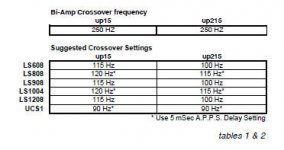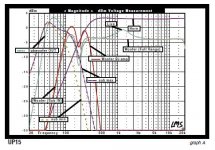Guys, The Yorkville Unity processor schematic is published in the service manual - this is a active version of the unity crossover. Also, actual crossover curves appear in the same service manual so is should not be a problem to model the same response in a DEX. Does anyone know what the time delay between tweeter and midrange drivers is?
http://www.yorkville.com/downloads/servman/smunity-p.pdf
I ended up measuring via DEQX and had it correct for phase using 96khz slopes at the stock 300hz and 1250hz crossover points.
Has worked out well. Now I'm on to making the woofer section completely active with an ICE ASP1000 module in each cabinet behind the woofer.
-Jim
I ended up measuring via DEQX and had it correct for phase using 96khz slopes at the stock 300hz and 1250hz crossover points.
Has worked out well. Now I'm on to making the woofer section completely active with an ICE ASP1000 module in each cabinet behind the woofer.
-Jim
Hi Jim,
We had talked previously as I have just received the u15p's as well. The U15p's need modification as Yorkville sells a processor for them that does the follwing:
- Time align the horn and woofer
- notch filter 160hz
- change crossover between the horn and woofer to 250hz.
I plan on using the dcx2496 with the Jan Didden active mod. I decided to keep the stock 15nd930 as I could apply a linkwitz transform filter on the dcx2496 to boost the rolloff at 100hz for a 20hz tuned cabinet. This should give deep and tight bass. See Cordell Audio: EQSS ™ for more details.
The only thing extra I need to figure out is what slopes or processing is being used for the mid to high range. Accoring to the schematics, its a big black box of DSP. Interesting that the crossover in the active version is 350hz...
BTW, how does the DEQx Unity sound to the passive version?
Daus
Attachments
Where do you buy the Misco drivers? Will the factory sell small quantities of stock items?
II've built a few unities, and I like the sound and the performance of computer speakers better than the pro sound midranges. For instance, Tang Band and Peerless sell some midranges that work nicely on a Unity. The Peerless and Tangband drivers include underhung motors, and shorting rings on the Peerless, which reduces inductance and harmonic distortion.
The Celestion, Eminence, and Misco options do not.
Something to consider if "clean" midrange is a priority.
The lowly Tangband paper cone mids work surprisingly well - as good as the Misco. Due to their small size, you can cross them over higher too. Obviously, power handling takes a hit.
Hello, I've noticed that usually the Unity's crossover between the horn and the woofers is around 250-300 Hz. Now, because you can probably achieve the same with a coaxial BMS or B&C compression driver on a large horn, I was wondering if the little 4" tangband or misco cones are able to go lower, to about 100Hz in a proper sized waveguide. What do you think?
Hello, I've noticed that usually the Unity's crossover between the horn and the woofers is around 250-300 Hz. Now, because you can probably achieve the same with a coaxial BMS or B&C compression driver on a large horn, I was wondering if the little 4" tangband or misco cones are able to go lower, to about 100Hz in a proper sized waveguide. What do you think?
If I'm not mistaken, the crossover on the Unity is somewhere around 900hz. You can download the crossover and model it in Speaker Workshop.
The bandwidth of the midranges is basically dictated by their thiele small parameters, and their location on the horn. To get the midranges to play low, you have to change the Thiele Small parameters. But the lower you try to make them play, the lower the high frequency cutoff is going to be. It's all related.
The trick isn't to get them to play low - that's trivial. The trick is to get them to play HIGH. It's really hard to push them high enough to meet the compression driver.
Thanks for the answers. My interest in Unity derives from the fact that I see just three ways to get the 100Hz - 500Hz Midbass region up to 105db levels.
1. Large horn with large and expensive compression driver - think goto, ale, community M2. Large format modern drivers won't do it. Maybe a small, very high efficiency closed back pro driver will.
2. Line array suffering from nulls and weird polar patterns.
3. A couple of 12 - 15" pro midranges in short horns. They are still big, and I find disturbing having two drivers playing on the same region with large distance from their acoustic centers. The distance between the midranges and the compression driver will also be huge.
So there I find the fourth option, a unity, with a coaxial compression driver playing down to 500-600Hz and the midrange drivers taking over at that point down to 100Hz. So that the midranges shouldn't cover more than 500 - 600 Hz. The large format coaxial CD will take over from there.
All this should be fitted in a large round waveguide, about 24" - 30" in diameter. Down and over the waveguide there will be 21" - 24" woofers, with enough heardroom to keep with the unity. The large woofers is the reason I need such a low crossover point for the Unity. I don't think such huge woofers can do well in the midbass.
And the full vertical array woofer - unity - woofer should be fitted in a wall, with an infinite baffle behind. The nice thing about this is that the array will only be 24" - 30" wide.
Ah, day-time dreaming..
1. Large horn with large and expensive compression driver - think goto, ale, community M2. Large format modern drivers won't do it. Maybe a small, very high efficiency closed back pro driver will.
2. Line array suffering from nulls and weird polar patterns.
3. A couple of 12 - 15" pro midranges in short horns. They are still big, and I find disturbing having two drivers playing on the same region with large distance from their acoustic centers. The distance between the midranges and the compression driver will also be huge.
So there I find the fourth option, a unity, with a coaxial compression driver playing down to 500-600Hz and the midrange drivers taking over at that point down to 100Hz. So that the midranges shouldn't cover more than 500 - 600 Hz. The large format coaxial CD will take over from there.
All this should be fitted in a large round waveguide, about 24" - 30" in diameter. Down and over the waveguide there will be 21" - 24" woofers, with enough heardroom to keep with the unity. The large woofers is the reason I need such a low crossover point for the Unity. I don't think such huge woofers can do well in the midbass.
And the full vertical array woofer - unity - woofer should be fitted in a wall, with an infinite baffle behind. The nice thing about this is that the array will only be 24" - 30" wide.
Ah, day-time dreaming..
Last edited:
Hi Jim,
We had talked previously as I have just received the u15p's as well. The U15p's need modification as Yorkville sells a processor for them that does the follwing:
- Time align the horn and woofer
- notch filter 160hz
- change crossover between the horn and woofer to 250hz.
I plan on using the dcx2496 with the Jan Didden active mod. I decided to keep the stock 15nd930 as I could apply a linkwitz transform filter on the dcx2496 to boost the rolloff at 100hz for a 20hz tuned cabinet. This should give deep and tight bass. See Cordell Audio: EQSS ™ for more details.
The only thing extra I need to figure out is what slopes or processing is being used for the mid to high range. Accoring to the schematics, its a big black box of DSP. Interesting that the crossover in the active version is 350hz...
BTW, how does the DEQx Unity sound to the passive version?
Daus
Daus, sorry for the delay. I just now saw your post. I really like what the DEQX does for my Unitys. There's something to be said for eliminating the passive components and going fully active with steep slopes. I could never go back.
-Jim
This is something that worries me: when I get my Unitys finished, a friend is going to bring his DEQX down and sub it for my DCX. My controller will easily be able to switch between the two controller outputs for AB comparison. The worrying part is the cost only as I've heard what they can do in a couple of systems so far.Daus, sorry for the delay. I just now saw your post. I really like what the DEQX does for my Unitys. There's something to be said for eliminating the passive components and going fully active with steep slopes. I could never go back.
-Jim
Hello, just a thought about this.
Have you seen the 3" midranges from FaitalPro? I know the 5" have been discussed but I can't remember something about these..
Have you seen the 3" midranges from FaitalPro? I know the 5" have been discussed but I can't remember something about these..
This is something that worries me: when I get my Unitys finished, a friend is going to bring his DEQX down and sub it for my DCX. My controller will easily be able to switch between the two controller outputs for AB comparison. The worrying part is the cost only as I've heard what they can do in a couple of systems so far.
I hear you. Its worth it, though. Trust me!
-Jim
- Status
- This old topic is closed. If you want to reopen this topic, contact a moderator using the "Report Post" button.
- Home
- Loudspeakers
- Multi-Way
- Modding the Yorkville Unity


